
Allium serra is a California species of wild onion known by several common names, including jeweled onion, pom-pon onion, and serrated onion.

Allium peninsulare is a North American species of wild onion. It is known by such common names as Mexicali onion and Peninsula onion; the former referring to the Mexican city just south of the US/Mexican border, the latter referring to the Peninsula of Baja California. It is widespread in California, USA, where it grows in the California Coast Ranges, Sierra Nevada foothills, some of the Channel Islands, and Peninsular Ranges. The range extends south into the northernmost part of Baja California and north into southern Oregon.

Allium haematochiton is a North American species of wild onion known by the common name redskin onion. It is native to northern Baja California, Sonora, and southern California as far north as Kern County. It grows on the slopes of the hills and mountains, such as those of the Peninsular Ranges, Transverse Ranges, and southern California Coast Ranges.

Allium amplectens, the narrowleaf onion, is a species of onion plant. It is native to the West coast of the United States, in Oregon, Washington State and California, also British Columbia in Canada. It grows in woods and especially in clay and serpentine soils.
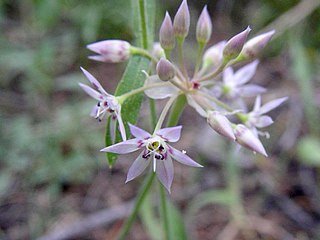
Allium campanulatum is a species of wild onion known by the common name dusky onion or Sierra onion. This is a flowering plant native to the western United States from southeastern Washington and northern Oregon to southern California, and western Nevada. The dusky onion grows in foothills and mountains, especially in dry areas, such as chaparral habitats.

Allium fimbriatum is a species of wild onion known by the common name fringed onion. It is native to California and Baja California.
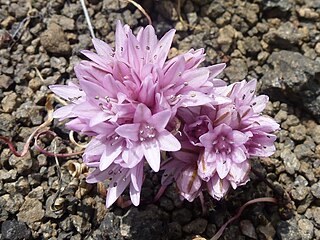
Allium parvum is an American species of wild onion known by the common name small onion. It is native to the western United States where it is a common member of the flora in rocky, dry areas in mountainous areas, especially in talus at elevations of 1,200–2,800 m (3,900–9,200 ft). It is widespread in California, Nevada, Oregon and Idaho, and also reported from western Utah and from extreme southwestern Montana
Eleocharis atropurpurea is a species of spikesedge known by the common name purple spikerush. This is an aquatic plant native to much of. It also has a wide distribution in temperate regions of North and South America and Asia. It is present in Europe, where it may be an introduced species for the most part.
Allium bolanderi is a species of wild onion known by the common name Bolander's onion. It is native to northern California and southwestern Oregon, where it grows in the rocky soils of the Klamath Mountains and surrounding regions.

Allium denticulatum is a species of wild onion known by the common name toothed wild onion. It is endemic to southern California, where it grows in the western Mojave Desert, the adjacent Tehachapi Mountains, the southern Sierra Nevada, and the Palomar Mountains. It is reported from Kern, San Bernardino, Riverside, Ventura, San Diego Counties.
Allium diabolense, common name serpentine onion or devil's onion is a species of wild onion endemic to central California, where it is known from the Coast Ranges and the Transverse Ranges. It grows on serpentine soils at elevations from 500 to 1500 m, from Kern and Ventura Counties north to Stanislaus and Santa Clara Counties.
Allium hoffmanii is a species of wild onion known by the common name beegum onion. It is native to northern California, where it grows in the serpentine soils of the local mountain ranges in Siskiyou, Humboldt, Trinity, Shasta, and Tehama Counties.

Allium howellii is a North American species of wild onion known by the common name Howell's onion. It is endemic to California.
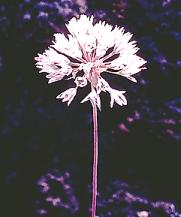
Allium jepsonii is a species of wild onion known by the common name Jepson's onion, honoring renowned California botanist Willis Linn Jepson.
Allium parryi is a North American species of wild onion known by the common names Parry's onion and Parry's fringed onion. It is common in the Coast Ranges of southern California and northern Baja California. It is also known from the southernmost reaches of the Sierra Nevada.
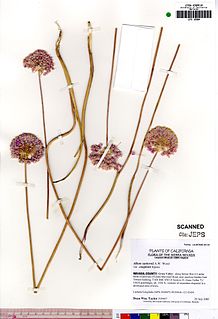
Allium sanbornii is a North American species of wild onion known by the common name Sanborn's onion. It is native to northern California and southwestern Oregon. It grows in the serpentine soils of the southern Cascade Range and northern Sierra Nevada foothills.

Allium siskiyouense is a North American species of wild onion known by the common name Siskiyou onion. It is native to the Klamath Mountains and nearby ranges of northern California and Oregon. It grows in serpentine and other rocky soil types.

Allium tribracteatum, known by the common name Threebract onion, is a species of wild onion found in California.
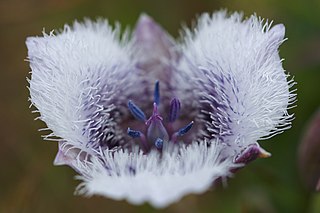
Calochortus tolmiei is a North American species of flowering plant in the lily family known by the common names Tolmie's star-tulip and pussy ears. It was discovered by and named for Dr. William Fraser Tolmie.

Calochortus uniflorus is a species of flowering plant in the lily family known by the common names Monterey mariposa lily and large-flowered star-tulip. It is native to western Oregon and to California as far south as San Luis Obispo County. It grows in moist areas, such as meadows, in coastal hills and lower-elevation mountains. Most of the populations are found in the Coast Ranges, but some occur in the Cascades and in the foothills of the Sierra Nevada.















